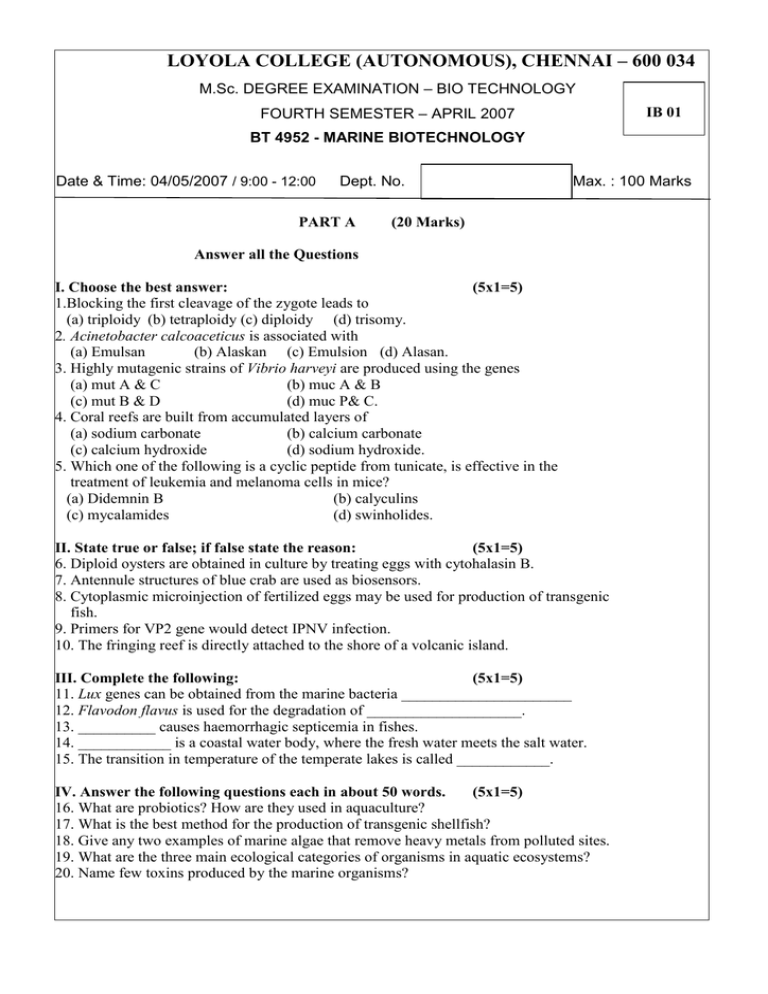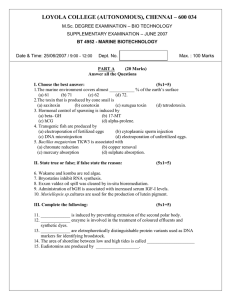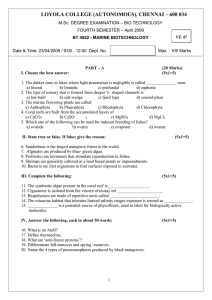LOYOLA COLLEGE (AUTONOMOUS), CHENNAI – 600 034
advertisement

LOYOLA COLLEGE (AUTONOMOUS), CHENNAI – 600 034 M.Sc. DEGREE EXAMINATION – BIO TECHNOLOGY FOURTH SEMESTER – APRIL 2007 IB 01 BT 4952 - MARINE BIOTECHNOLOGY Date & Time: 04/05/2007 / 9:00 - 12:00 Dept. No. PART A Max. : 100 Marks (20 Marks) Answer all the Questions I. Choose the best answer: (5x1=5) 1.Blocking the first cleavage of the zygote leads to (a) triploidy (b) tetraploidy (c) diploidy (d) trisomy. 2. Acinetobacter calcoaceticus is associated with (a) Emulsan (b) Alaskan (c) Emulsion (d) Alasan. 3. Highly mutagenic strains of Vibrio harveyi are produced using the genes (a) mut A & C (b) muc A & B (c) mut B & D (d) muc P& C. 4. Coral reefs are built from accumulated layers of (a) sodium carbonate (b) calcium carbonate (c) calcium hydroxide (d) sodium hydroxide. 5. Which one of the following is a cyclic peptide from tunicate, is effective in the treatment of leukemia and melanoma cells in mice? (a) Didemnin B (b) calyculins (c) mycalamides (d) swinholides. II. State true or false; if false state the reason: (5x1=5) 6. Diploid oysters are obtained in culture by treating eggs with cytohalasin B. 7. Antennule structures of blue crab are used as biosensors. 8. Cytoplasmic microinjection of fertilized eggs may be used for production of transgenic fish. 9. Primers for VP2 gene would detect IPNV infection. 10. The fringing reef is directly attached to the shore of a volcanic island. III. Complete the following: (5x1=5) 11. Lux genes can be obtained from the marine bacteria ______________________ 12. Flavodon flavus is used for the degradation of ____________________. 13. __________ causes haemorrhagic septicemia in fishes. 14. ____________ is a coastal water body, where the fresh water meets the salt water. 15. The transition in temperature of the temperate lakes is called ____________. IV. Answer the following questions each in about 50 words. (5x1=5) 16. What are probiotics? How are they used in aquaculture? 17. What is the best method for the production of transgenic shellfish? 18. Give any two examples of marine algae that remove heavy metals from polluted sites. 19. What are the three main ecological categories of organisms in aquatic ecosystems? 20. Name few toxins produced by the marine organisms? PART B V. Answer any five of the following questions each in about 350 words:(5x8=40) 21. Describe the zonations characterized by standing water ecosystem. 22. Discuss briefly about genetically engineered marine algae. 23. Explain the removal of oil spills by marine organisms. 24. Describe the use of recombinant hormones and growth factors in aquaculture. 25. Illustrate the physico- chemical aspects of marine environment. 26. Briefly discuss the benthic environment distribution. 27. Describe the marine natural products and their medical applications. 28. Write notes on (a) induced breeding. (b) Molecular diagnostics for fish viruses. PART C VI. Answer the following questions each in about 1500 words: (2x20=40) 29. (a) Discuss the production and applications of transgenic finfish, shellfish and shrimp. (or) (b) Give an account of the genetic and hormonal manipulation of reproduction in fishes. 30. (a) Give a brief account on bioluminescence phenomenon and their applications. (or) (b) Discuss the salient aspects of fresh water ecosystem. ************* 2








